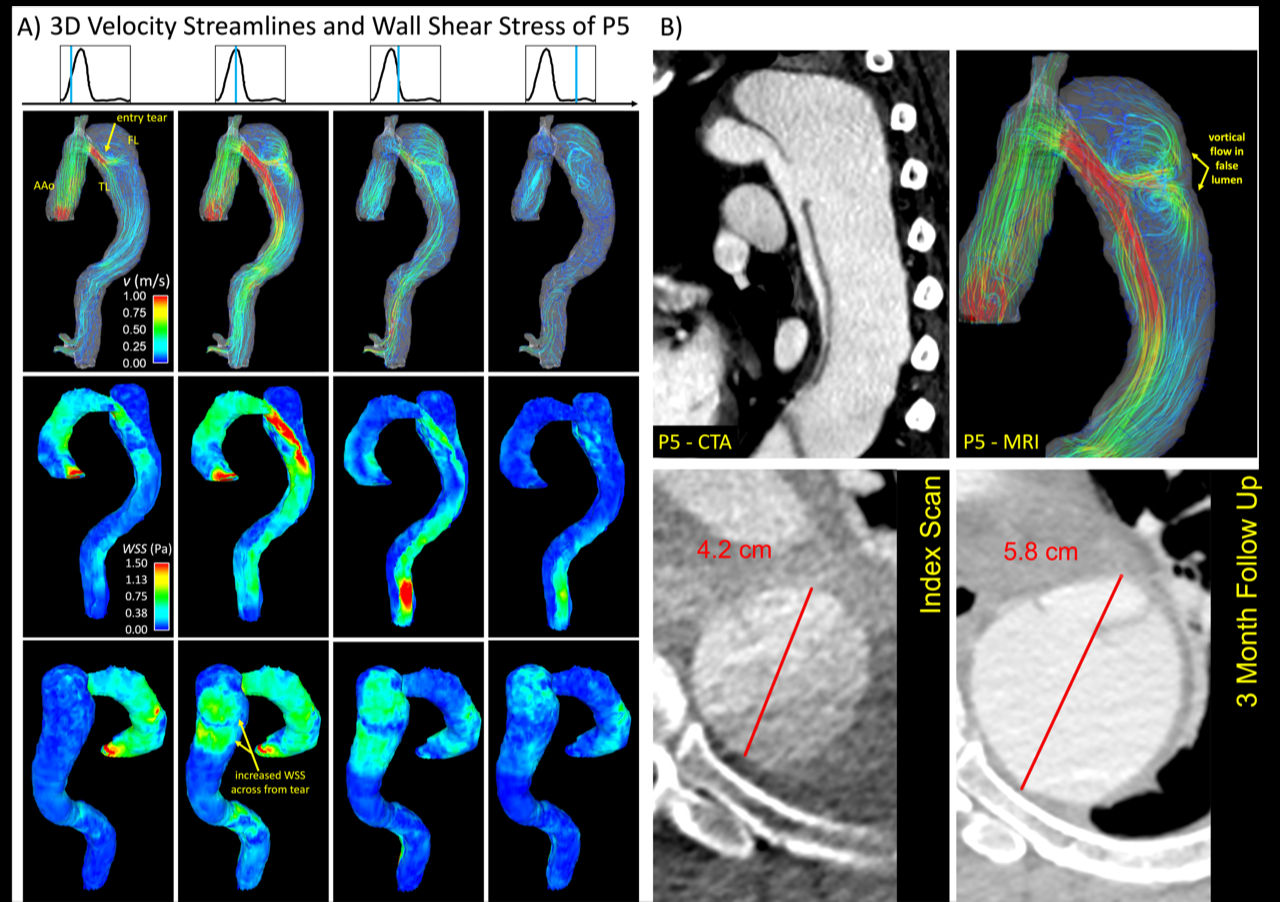Final ID: Mo1143
Hemodynamics of Acute Type B Aortic Dissections with 4D Flow MRI
Abstract Body (Do not enter title and authors here): Background: Type B aortic dissections (TBAD) develop from a tear in the intimal layer of the aorta, distal to the left subclavian artery. This tear separates the aorta into true (TL) and false lumens (FL), increasing the risk of dilation and rupture. In cases of surgical intervention, treatment for type B aortic dissections (TBAD) after the acute phase (> 14 days) is associated with worse outcomes. Identification of those patients who will experience aortic growth could identify patients who would benefit from early intervention. This study aims to characterize blood flow for risk stratification using 4D flow MRI. We identified possible markers of interest: entry tear velocity, pulse wave velocity (PWV), and wall shear stress (WSS).
Methods: TBAD patients (n = 7; 3 F) from Emory University Hospital were enrolled. We acquired 4D flow MRI during the acute phase (3T Prisma Fit; Siemens Healthcare). We created image-derived 3D models of lumens and measured velocity at entry tears. We estimated PWV using cross correlation of waveforms at perpendicular, evenly-spaced planes throughout the true lumens. We estimated WSS throughout the false lumen using a previously developed method (Matlab, Ansys EnSight). Growth rates were measured from at follow up computed tomography exams.
Results: Three of the patients (P2, P3, P7) did not grow, while P1, P4-P6 grew 2.1, 1.2, 5.3, and 2 mm/month, respectively. Peak entry tear velocities were higher in growth (143 cm/s) than non-growth (90 cm/s) cases, with P5 having the highest (180 cm/s). Forward flow was greatest in the distal end of FL near visceral branches (growth = 17.1, non-growth = 11.0 ml/cycle). Pulse wave velocity measurements between growth and non-growth were similar (4.5 and 3.5 m/s). Both averages were lower than PWV for non-dissected aortas. Regions of high vorticity and WSS can be observed in the true and FL near tears, but no trends were found between growth and non-growth cases.
Conclusion: We anticipate stronger trends as enrollment continues, but our preliminary findings demonstrate the first MRI study to enroll acute TBAD subjects and identify markers of interest.
Sources of Funding: This study is supported by NIH R01HL155537 and the National Center for Advancing Translational Sciences under Award Numbers UL1TR002378 and TL1R002382.
Methods: TBAD patients (n = 7; 3 F) from Emory University Hospital were enrolled. We acquired 4D flow MRI during the acute phase (3T Prisma Fit; Siemens Healthcare). We created image-derived 3D models of lumens and measured velocity at entry tears. We estimated PWV using cross correlation of waveforms at perpendicular, evenly-spaced planes throughout the true lumens. We estimated WSS throughout the false lumen using a previously developed method (Matlab, Ansys EnSight). Growth rates were measured from at follow up computed tomography exams.
Results: Three of the patients (P2, P3, P7) did not grow, while P1, P4-P6 grew 2.1, 1.2, 5.3, and 2 mm/month, respectively. Peak entry tear velocities were higher in growth (143 cm/s) than non-growth (90 cm/s) cases, with P5 having the highest (180 cm/s). Forward flow was greatest in the distal end of FL near visceral branches (growth = 17.1, non-growth = 11.0 ml/cycle). Pulse wave velocity measurements between growth and non-growth were similar (4.5 and 3.5 m/s). Both averages were lower than PWV for non-dissected aortas. Regions of high vorticity and WSS can be observed in the true and FL near tears, but no trends were found between growth and non-growth cases.
Conclusion: We anticipate stronger trends as enrollment continues, but our preliminary findings demonstrate the first MRI study to enroll acute TBAD subjects and identify markers of interest.
Sources of Funding: This study is supported by NIH R01HL155537 and the National Center for Advancing Translational Sciences under Award Numbers UL1TR002378 and TL1R002382.
More abstracts on this topic:
A Rare Case Of Localized Ventricular Tachycardia Due To Mitral Annular Disjunction And a Subvalvular Aneurysm
O'toole Timothy, Binder Michael, Hama Amin Ali
A Comparison Between Global Longitudinal Strain (GLS) Derived with CMR Feature-Tracking (CMR-FT) and 2D Speckle-Tracking Echocardiography (2D-STE) to Monitor Cancer Therapy-Related Cardiac Dysfunction (CTRCD)Kar Julia, Cohen Michael, Revere Cherie, Mcquiston Samuel, Malozzi Christopher

